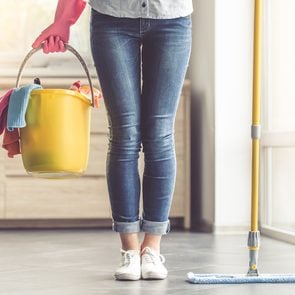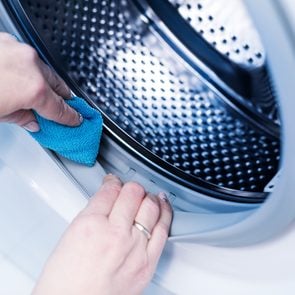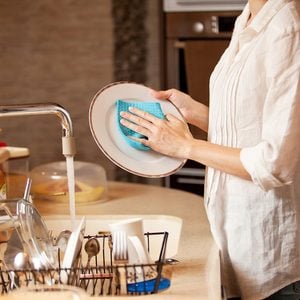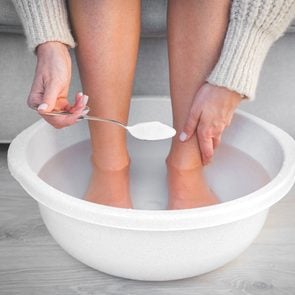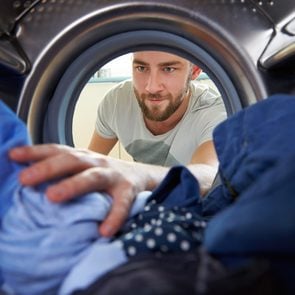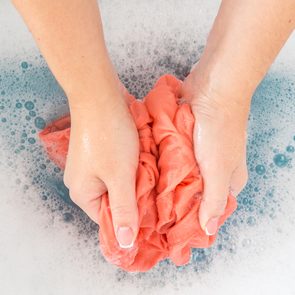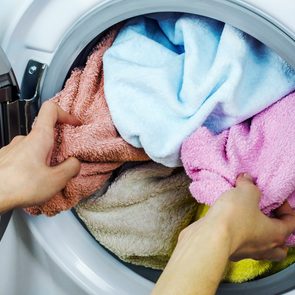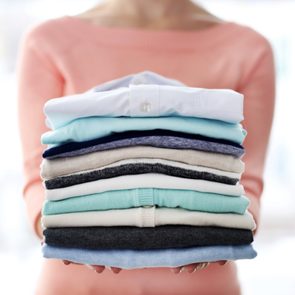Ready for an oddly satisfying way to deep-clean your laundry? Laundry stripping is a method of washing clothes, sheets and towels that allows you to actually see all the dirt and grime that’s hanging out on your supposedly clean linens. It’s kind of gross; but also totally gratifying when you’re done, knowing your laundry is probably the cleanest it has ever been.
Here’s everything you need to know about laundry stripping—and how to DIY.
What is laundry stripping?
Laundry stripping is essentially a soaking method meant to deep-clean your laundry. The soak is done in a Borax solution that removes built-up residue from detergent, hard water, body oils and fabric softener. What makes it so satisfying (but also might leave you slightly horrified) is that often the soaking water turns brown or gray from all the gunk that is “stripped” away from your linens! (Here’s how to tell if you’re using too much laundry detergent.)
How to strip your laundry
You’ll need:
- Borax
- Washing soda (sodium carbonate)
- Laundry detergent
- Bathtub (or large bucket)
Step 1: Make the soaking bath
First, you’ll need a vessel large enough to soak the linens you want to strip. We recommend using the bathtub, but you could also use a large bucket or bin. Fill the bathtub with hot water. Add one part Borax, one part washing soda and two parts laundry detergent. For a bathtub, we recommend ¼ cup Borax, ¼ cup washing soda and ½ cup detergent.
Gently stir the water to dissolve the powders.
Step 2: Soak the linens
Add clean laundry to the water, completely submerging it. Let everything soak about four to five hours, or until the water is cool. Stir the water and swish the laundry around occasionally; the movement helps to remove the dirt and grime from the fabric.
Step 3: Rinse
Remove the laundry from the bathtub and drain the water. (Don’t forget to admire the gross murky brown colour!) Now run the laundry through the washing machine, using a rinse cycle without detergent. Dry the laundry as you normally would; then enjoy your crisp, super-clean linens!
When you should (and should not!) use laundry stripping
Laundry stripping is great for sheets and towels because those items are used frequently and can easily collect a buildup of body oils and detergents. If your towels feel less absorbent than usual, and your sheets look a little dingy, it might be time to try your hand at laundry stripping.
Be careful with colourful linens, because laundry stripping can cause dyes to run. You’ll also want to avoid delicate linens like lace or embroidered pieces. Also, clothing isn’t a great candidate for stripping.
Remember, laundry stripping requires hot water; so keep that in mind and check care label tags before you get started.
Next, find out the laundry mistakes you’ve been making—and what to do instead!
Ontario is home to more than 200 ghost towns, but few are as famous as Balaclava. Situated in Renfrew County in Eastern Ontario, the site is well-known for its rundown sawmill (above), which sits along a shallow river and is surrounded by rotting tree logs, pieces of machinery and wagon wheels.
Intrigued visitors can find this town on Scott Bush Road, just north of the community of Dacre. Unsurprisingly, Balaclava has for years been a favourite destination for urban explorers and photographers alike.
“There are a couple reasons for the appeal of ghost towns,” says Ontario historian and author Ron Brown. “They recall those days of yore when we saw those tumbleweed ghost towns in cowboy movies, but to me and others, it’s also the appeal of finding artifacts or just getting the sense that there was once a place here, with people and businesses.”
The Rise and Fall of Balaclava, Ontario
The town takes its name from the Battle of Balaklava, a skirmish during the Crimean War in the 1850s. In its heyday, Balaclava was a flourishing lumber town that produced up to one million board feet of lumber per week. The sawmill at the heart of the community, one of Ontario’s last water-powered mills, was erected in 1855. It was partially destroyed by a fire in 1936 but rebuilt three years later. The structure remains standing to this day, but in such a state of disrepair, it’s best to admire it from afar.
Balaclava was also the site of Ontario’s first-ever environmental lawsuit, says Brown. The Richards family bought the sawmill in 1868, but in 1911, they were taken to court when a nearby grist mill complained that the family was disposing too much sawdust into the river. The grist mill won the case, and the Richards were required to pay $200 USD in restitution. The lawsuit also resulted in the addition of a sawdust burner.
By the mid-1950s, depleted timber supply in surrounding areas meant the sawmill was only producing a few thousand board feet every year. Soon, it was forced to shut down, along with Balaclava’s general store. (A host of other shops and businesses had already shuttered several years earlier.) Bypassed by railways and with its only industry gone, Balaclava—once home to approximately 200 residents—was abandoned. In the following years, town staples like the general store, blacksmith shop (below), two hotels and sawmill, either burned down, were dismantled or fell into decay.
Brown has been researching Ontario’s ghost towns, railways and unusual attractions for more than 40 years. The 75-year-old Toronto resident first visited Balaclava in the summer of 1996, and then again in August 2018.
On his first visit to Balaclava, Brown remembers a lovely row of wooden buildings and houses with still-intact porches lining the main street, describing it at the time as a “classical ghost town.” But on his second visit, he recalls Balaclava’s atmosphere felt more sad than eerie—in contrast with the notion that ghost towns are haunted and hair-raising sites.

Balaclava Today
Balaclava’s crumbling remains are something visitors may want to catch before they’re lost to the elements or rebuilt. In fact, the latter is slowly taking place. The collapsing attachment to the general store, for instance, was torn down and the building made into a hunting camp.
“There was an initiative maybe 15 years ago to preserve [the sawmill], but the property owners didn’t want anything to do with that,” says Brown. “We do not have very good heritage preservation standards in this province, so [the sawmill] sits, falling apart.”
That’s right: the sawmill is currently privately owned, with reports of threats to demolish it if people continue trespassing. According to Brown, there are also a few occupied homes in the general area of Balaclava.
Since the abandoned buildings are still private property, Brown says those who want to visit Balaclava should be mindful. Ask the sawmill’s owner—likely to be found in the nearest building to the mill—for permission first if you want to get a closer look. It also doesn’t hurt to try and strike up conversations with nearby residents, Brown says.
“My mission is to encourage people to explore the heritage which is in their own backyards, whether it’s a built heritage like mills or ghost towns, or geological heritage,” he says. “And there’s a lot of that out there too, which is quite fun.”
Now that you know the story of Balaclava, Ontario, check out 10 Canadian castles worth exploring.
If the brake light illuminates on your dashboard, don’t panic. But, take it seriously, as brakes are probably the most important safety feature on your car. The first thing to check, and by far the most common reason the light comes on, is kind of a “duh” moment: You’ve left the parking brake fully or partially engaged. Pull the brake release and see if that solves the light issue. In most cases it does.
Next on the checklist of causes for an illuminated brake light is the brake fluid level. Under normal conditions you should not have to add brake fluid, as it works in a sealed system. But, if a leak develops, the system will lose fluid which impairs the stopping power of the brakes. You can add fluid as a stop-gap, but if you have a leak in your pneumatic braking system, you need to have it repaired or you may lose enough fluid to cause your brakes to fail. (These tips on how to change brake fluid could come in handy.)
Finally, as with “Check Engine” lights, brake lights themselves can fail or false indicate. Or, the sensors that trigger the light may be faulty. Don’t assume at the onset of the light that a bad sensor or readout light is behind it, but if there appears to be no other problem, have your service provider investigate the indicator light itself and the sensors. (Find out what every dashboard warning light really means.)
A brake light could also indicate an issue with your ABS
Modern cars have automatic brake systems (ABS) that prevent the brakes from locking up in emergency braking situations. Most ABS systems have their own indicators, so if you have an issue with your ABS you’ll likely see the brake light illuminated as well as an ABS indicator light. ABS systems have sensors in the brakes that are linked to a chip in your car’s computer system, so dealing with them requires servicing at a car service centre that can read engine codes. If you are a very dedicated home mechanic, consider investing in your own code reading device. They range from basic models that simply give you a numeric readout that you can look up, to more sophisticated ones that display the nature of the code issue or engine problem.
Next, find out what these strange car noises are trying to tell you.

Unsung Canadian Heroes
Charles “Checker” Marvin Tomkins (1918-2003)
The Cree speaker who helped win WWII
As a member of a classified project that involved encrypting sensitive information during the Second World War, Tomkins was accustomed to keeping secrets. He was so good at it, in fact, that it wasn’t until documentary filmmakers came calling shortly before his death in 2003 that Tomkins’s family learned that he had served as a Cree code talker—a member of a unique military intelligence unit made up of Indigenous servicemen.
A Métis Cree speaker, Tomkins grew up in a large family in Grouard, Alberta. Stationed in England in 1940, he was tasked with “encrypting” messages into Cree. These would then be sent elsewhere in the field, where another Cree code talker would translate the information back into English. Tomkins and his fellow Indigenous encryption officers were true Canadian heroes who played an integral role in transmitting intelligence and protecting the troops.

Portia White (1911-1968)
The singer who broke barriers
As a Black artist, White was one of the first to shatter colour barriers in Canada. Born in Truro, Nova Scotia, she trained as a contralto at the Halifax Conservatory of Music. In the 1940s, she entranced audiences worldwide with her powerful renditions of “Think on Me” and “He’s Got the Whole World in His Hands.” Despite the international acclaim, White faced constant racism and was often barred from restaurants and hotels in the cities she toured. But she never gave up. “Nobody ever told me to sing,” White once said. “I was born singing.”
In 1944, Nova Scotia created a charity in White’s name, awarding Black artists with scholarships and prizes. Her fame set the stage for countless Black Canadian musicians. “If it wasn’t for Portia White,” says her niece, Sheila White, an accomplished pianist and composer, “there wouldn’t be a Drake.”

Maayan Ziv (b. 1990)
The entrepreneur making our cities more accessible
Born with muscular dystrophy, Torontonian Ziv often faced uncertainty whenever she left her home. “I use a wheelchair and I’d go to locations that were inaccessible without knowing I’d encounter that problem,” she says. “I decided to build a tech company to help people like me navigate an inaccessible world.”
In 2015, Ziv started AccessNow, an online platform that allows users to see whether a location has ramps, elevators, accessible washrooms and more. Today, it provides information on 200,000 locations in 35 countries, and helps tens of thousands of users. “That’s all the motivation I need,” says Ziv. “My goal is to share accessibility information about every single place on the planet.”
John Brackett (1890–1958)
The mariner who saved Halifax Harbour
On November 3, 1943, Brackett witnessed a crew desperately trying to put out a fast-spreading fire on the U.S. freighter Volunteer. As a civilian harbour pilot, the 53-year-old ran a team of tugboats that navigated ships in and out of Halifax Harbour. He immediately recognized the looming danger: the freighter carried enough explosive munitions to destroy the harbour and half of Halifax—and it was minutes from blowing up.
Brackett jumped aboard the Volunteer and quickly guided a pair of tugboats to pull the ship out of harm’s way. Once the freighter arrived at a nearby island, the crew flooded the holds to douse the fire, saving the city.
Albertine Lapensée (1898-unknown)
The star who changed hockey
Born in 1898, Lapensée learned to skate on iced-over creeks. When the First World War sent men to the Western Front, a Québécois arena owner dreamed up the Eastern Ladies’ Hockey League—and Lapensée seized her opportunity. Between 1916 and 1917, she demonstrated astonishing skill, leading the Cornwall Victorias to glory after glory. Francophone fans referred to her as “l’Étoile des étoiles”—the star of stars. She once scored 15 goals in a single game. And then, at 18, she left the spotlight. Little is known about her later life, but she remains an undercelebrated icon of Canada’s most beloved game.
Take a peek at 20 fascinating artifacts you’ll find in Canadian museums.

Hide Hyodo Shimizu (1908-1999)
The teacher who campaigned for reparations
In 1942, the Canadian government expelled elementary school teacher Shimizu and her family from their Vancouver home and forced them, along with an estimated 22,000 Japanese Canadians, to live in an internment camp through the Second World War. Shimizu, who was born in Vancouver, spent three years in the camps. During that time, she organized the education of over 2,000 Japanese-Canadian children detained throughout British Columbia—ensuring they didn’t fall behind.
She didn’t stop there. Shimizu also advocated for Japanese Canadians’ right to vote, which was won in 1949, as well as reparations for interned Japanese Canadians. In 1988, Prime Minister Brian Mulroney formally apologized for Canada’s actions during the war, established a $12-million community fund and paid a token $21,000 to each Japanese-Canadian survivor.

Dr. Frances McGill (1877-1959)
The doctor who solved murder mysteries
McGill graduated at the top of her med school class at the University of Manitoba in 1915 and promptly put her credentials to good use. As the Spanish flu pandemic raged in 1918, McGill, then Saskatchewan’s head bacteriologist, led a campaign to provide tens of thousands of vaccinations. Later, her interest in public health inspired her to work on treatments for a host of different allergies.
McGill is perhaps best known, however, as Canada’s answer to Sherlock Holmes. Between 1922, when she became Saskatchewan’s chief pathologist, and the 1940s, when she formally retired, she kept busy cracking unsolved cases. McGill’s skill at reading corpses and crime scenes transformed the field of criminology: whether she was piecing together a shattered skull or examining posthumous tissue, she was able to discern truth from the murky mysteries of the body.
These Canadian true crime podcasts are worth adding to your playlist.

Kew Dock Yip (1906–2001)
The lawyer who challenged the Chinese Immigration Act
In the early 1940s, when Vancouver-born Yip enrolled in law school, individuals of Asian descent were forbidden to practise law in British Columbia. In fact, Asian people were also denied the right to vote in Canada. Neither fazed the Chinese-Canadian polymath, who graduated from Toronto’s Osgoode Hall in 1945. In turn, he successfully lobbied the court to strike down the Chinese Immigration Act—a law dating back more than two decades that prevented Chinese immigrants from entering the country. Yip wasn’t content to rest on his laurels. Even after establishing a thriving law practice and making brief forays into public service and acting (including an appearance in a Cyndi Lauper music video), he never stopped learning: in his mid-’80s, he re-enrolled in university because he wanted to study Shakespearean English.
Gwen Barlee (1963–2017)
The environmentalist who protected endangered species
The daughter of a B.C. MLA, Barlee’s childhood was spent debating politics and learning about the majesty of nature. Devoting her life to the public good, she joined the Wilderness Committee, where she became a ferocious advocate for the protection of endangered species, such as the northern spotted owl. Not long before she died in 2017 of cancer, she presented the B.C. legislature with a petition, signed by 40,000 residents, to establish a law to protect species at risk. Joe Foy, Barlee’s friend at the organization, says she showed that “You don’t have to be wealthy and powerful—you just have to be aware and care, and you can make a difference.”
Nellie Cournoyea (b. 1940)
The politician who changed the North
Lauded for her “tough, pragmatic approach, and her relentless work ethic,” in the words of a former colleague, Cournoyea is also a force to be reckoned with. The first Indigenous woman to lead a province or territory, she became a member of the legislative assembly in 1979 and served as premier of the Northwest Territories from 1991 to 1995. For the next 20 years, until her retirement in 2016, Cournoyea chaired the Inuvialuit Regional Corporation, ensuring Inuvialuit had a say (and a share) in the economic fortunes of the region and also administering the historic land-claim settlements she worked to secure while in the legislature.
Inspired to learn about more Canadian heroes? Add these great Canadian history podcasts to your playlist.

Michelle Douglas (b. 1963)
The officer who opposed discrimination
When Ottawa’s Douglas enlisted in the Canadian Armed Forces in 1986, it felt like a dream come true. She was devastated when, two years later, she became the subject of a vicious investigation on account of her sexuality. At the time, the military considered LGBTQ2S+ individuals subversives and threats to national security; Douglas was discharged. In response, she took the CAF to court. In 1992, the Federal Court of Canada ruled in her favour, calling for an end to the military’s discriminatory practices. In turn, 718 survivors of the LGBT Purge filed a class-action lawsuit against the federal government and won a settlement of up to $145 million. Douglas is now the executive director of the LGBT Purge Fund, advancing human rights for LGBTQ2S+ people. “I wish I could go back and tell myself what I’d tell anyone struggling,” she says. “‘Don’t give up. You are beautiful, you are loved and you are worthy.’”
Ron Deibert (b. 1964)
The professor safeguarding the Internet
Since founding the Citizen Lab research centre in 2001, University of Toronto professor Deibert has published more than 120 eye-opening reports on cyber espionage, commercial spyware and internet censorship. He first made international headlines in 2009, when the Citizen Lab uncovered a China-based spyware attack on hundreds of computers, including those of the Dalai Lama. Deibert’s report on the massive scope of the attack, which spanned 103 countries, spotlighted the wide extent of digital espionage—and the urgent need to do something about it. Since then, the Citizen Lab has detected and exposed spyware being used by authoritarian regimes to monitor political dissidents, human rights activists and journalists worldwide. “If we had 25 Citizen Labs sprinkled around the planet,” says Deibert, “there would be another protective layer of dogged researchers who aren’t afraid to uncover abuses of power, no matter where they are.”
Marion de Chastelain (1910–2000)
The Allied agent who spied on the Nazis
De Chastelain could be a character in a James Bond movie. After the First World War, her father moved their family from New York to Romania. Marion became a polyglot, studied law at the Sorbonne, rubbed shoulders with European aristocracy and married a London oil baron. Her cosmopolitan life equipped her for a career as an international spy. During the Second World War, she was recruited by British intelligence as a transcriptionist. She later joined the counter-intelligence branch of MI6, running operations in Vichy France and in the Balkans. After the war, she became a bona fide Canadian, settling in Alberta with her husband and children, where she remained until her death in 2000.
Here are more inspiring Canadian women you didn’t learn about in history class.
Hussain Guisti (b. 1967)
The businessman building mosques across Canada’s North
In 2006, Guisti and his family relocated from Winnipeg to Thompson, Manitoba—only to discover it didn’t have a mosque. In response, Guisti started the Zubaidah Tallab Foundation and raised donations to build one. The building opened its doors in 2007. Next, the Muslim community of Inuvik, N.W.T., asked him for help. He raised $323,000 and in late 2010, the mosque welcomed its first worshippers. Guisti has since built mosques in Whitehorse and Iqaluit, with Yellowknife up next. “These Muslims now have mosques where they can come together, put down roots and flourish,” he says.
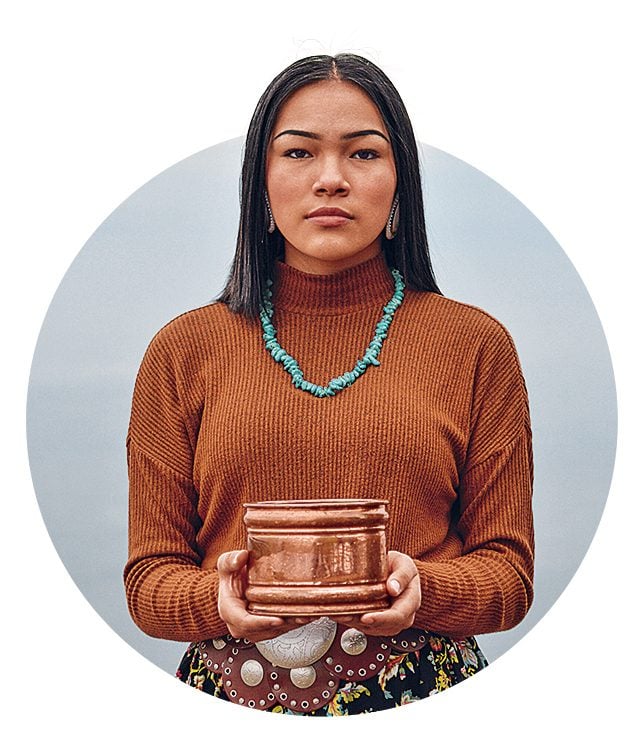
Autumn Peltier (b. 2004)
The teen fighting for clean water
In 2018, Peltier, a 13-year-old member of Wiikwemkoong First Nation, addressed the United Nations General Assembly in New York City for World Water Day, imploring them to “warrior up” and stop polluting the planet’s water. “No child should grow up not knowing what clean water is,” she said. The following year, the Anishinabek Nation appointed her their chief water commissioner, a role that has her advocating for the 29 First Nation communities that lack clean drinking water. Years later, she’s still at it. “It’s unacceptable that a country as rich in resources as Canada can treat its Indigenous people so poorly,” says Peltier.
Here are 10 Indigenous authors you should be reading.

Waneek Horn-Miller (b. 1975)
The Olympian inspiring the next generation
At 14, Horn-Miller had a near-death experience that changed her life. While standing in solidarity with fellow Mohawks during the 1990 Oka Crisis, the escalating tensions between protestors and the Canadian military and provincial police erupted into violence. As she attempted to carry her four-year-old sister, Kaniehtiio Horn, to safety, a soldier stabbed her in the chest with a bayonet. She survived the incident and used the trauma to fuel her dream of becoming an Olympic athlete. “I channelled all the anger, pain and sadness from my experiences into something positive and empowering,” she says.
In 2000, as co-captain of the national water polo team, Horn-Miller became the first Mohawk woman to represent Canada at the Olympics. The 46-year-old now serves as a motivational speaker, helping Indigenous youth build self-esteem and achieve their dreams through education and sport.

George Klein (1904–1992)
The engineer behind 1,000 technologies
Klein helped invent aircraft skis, a life-saving microsurgical staple gun used to suture blood vessels and the first Canadian nuclear reactor, among many other wonders. But he is probably best known for designing the first mass-produced electric wheelchair in 1953, which transformed the lives of countless quadriplegic Canadian Second World War veterans. When Klein was in his 70s, the National Research Council of Canada pulled him out of retirement to help design the Canadarm, an innovative robotic arm used in NASA’s space shuttle program. Three years after he died, Klein was inducted into the Canadian Science and Engineering Hall of Fame, where he joined the likes of Alexander Graham Bell and Frederick Banting.
Discover more Canadian contributions to the exploration of space.

Rachel Zellars (b. 1974)
The educator empowering Black children
In 2020, Halifax lawyer and professor Zellars co-founded the African Nova Scotian Freedom School. The original Freedom schools emerged during the 1960s U.S. Civil Rights Movement. “I wanted to give Black children the tools and support to understand this ongoing pivotal moment of their history,” says Zellars, “which they simply wouldn’t get in public school.” The courses educate Black youth on their rich heritage and also teach skills to help students become community organizers. She dreams of her work becoming a template for new schools across Canada, creating future generations of Black leaders.
Reginald Aubrey Fessenden (1866–1932)
The radio pioneer who connected us to the world
Fessenden is one of Canada’s most influential, but least celebrated, engineer-inventors. Born in 1866 and raised in Ontario, he cultivated an early interest in science, sparked as much by the influence of his own uncle, a physics teacher, as by Alexander Graham Bell’s telephone transmissions in nearby Bolton, Ontario. By 1906, he was responsible for pulling off the first two-way transatlantic transmission, during which he invited naval officers at sea to tune in to a Christmas Eve program of music and good cheer. He attempted countless experiments, many of which resulted in serendipitous discoveries that range from sonar technology for boats to tea infusers and an X-ray machine.
Mary Ann Shadd Cary (1823–1893)
The newspaper publisher who campaigned against slavery
“Self-reliance is the true road to independence.” That was the tag line of The Provincial Freeman, an antislavery broadsheet first published in 1853 in Windsor, Ontario. It could also be the motto of the paper’s publisher and editor, Shadd Cary. Born in Delaware, she later relocated to Canada and founded The Provincial Freeman to celebrate the free Black community. Being the first Black woman to publish a newspaper—in the pre-Civil War era, no less—might seem like the accomplishment of a lifetime, but it was just one of many for an individual who committed her life to activism, abolition and education.
Next, put your knowledge of Canadian heroes to the test with our great Canadian trivia quiz.
You stay on top of your bathroom cleaning routine, yet icky slime, in shades of pink, still lurks in your shower. What is it—pink mould, orange mildew, red fungus? And more important, how can you put a stop to this goo?
Don’t be embarrassed. Every bathroom has seen its share of unsightly substances. Here is the scoop on exactly what this shower slime is, how to remove it and ways to prevent it from returning—with the least amount of effort.
What is that pink gunk in your shower?
It may be commonly called pink mould, but this gross slime isn’t really mould at all. “The pink gunk is really an airborne bacterium called Serratia marcescens,” says Steve Stephenson, PhD, a researcher in the Department of Biological Sciences at the University of Arkansas who wrote not one but three books on slime moulds.
And while people may casually call the gunk “pink mould,” the bacteria can take a range of shades—from pink to orange to red—depending on bathroom conditions like temperature, humidity levels and sunlight.
What causes pink mould in the shower?
Before you start worrying that you’ve done something wrong, know that pretty much everyone has encountered the unappealing slime at some point or another. “It would not be uncommon to find S. marcescens in the bathroom,” says Stephenson. After all, it thrives in moist environments like—you guessed it—your shower.
These bacteria live on a diet of minerals and fats. With the mineral deposits in soap scum and fats found in shampoo residue, your shower is a buffet for these little guys. They love to hide in grout lines, caulk crevices and around shampoo bottles.
Is pink mould harmful?
Unlike toxic black mould that can cause health concerns, pink mould in the shower isn’t a concern for the average person with a healthy immune system. But it’s still gross, and under the right conditions, the colony will continue to flourish, exposing you to even more spores.
It’s better to be safe than sorry, especially if you have a compromised immune system. So if you see it, scrub it. (Here’s how to boost your immune system, naturally.)
How do you get rid of pink mould?
Good news: It won’t take a lot of effort to wipe out the pink mould in your bathroom. You can use a specialty cleaning product to work the buildup from your shower. But there are homemade options that’ll do the trick too.
Vera Peterson, president of Molly Maid, prefers a paste made from items you probably have on hand. Simply mix four parts baking soda with one part liquid dish soap. Common pantry ingredients make this DIY solution one of the best eco-friendly bathroom cleaning products. And as an added bonus, making your own shower scrub will save you money.
Using the paste is also easy. Apply it to your shower, wait 10 minutes and then (wearing cleaning gloves to protect your hands) scrub away the pink residue . Finish by drying the shower completely with a fresh microfibre cloth. (Leave it damp, and the dreaded pink slime will return.)
How do you prevent pink mould?
To win the battle against pink mould, you don’t have to give up your hot shower or steamy bath. Try these techniques to banish pink mould in the shower forever—or at least give you a little more time before the bacteria set up house again.
Ventilate
Use the exhaust fan for 30 minutes after showers. If you don’t have an exhaust fan, try a small, battery-operated desk fan to get the air moving. Stephenson says the best defense against pink mould is keeping moisture levels down as much as possible. But it is a bathroom with, well, lots of water. So you may need to try other solutions as well.
Squeegee
After every shower, squeegee the walls and, if you have them, glass doors. Or try Peterson’s suggestion to prevent buildup: Spritz a leave-on commercial shower spray when you get out of the shower.
Dry
Between grout scrubbings and deep cleanings, wipe away soap and shampoo residue everywhere it collects. Don’t forget to dry surfaces!
Go antimicrobial
Invest in quick-dry bath mats and shower curtain liners with antibacterial properties. And when laundering machine-washable curtains and liners, toss in a few old towels. They act as scrubbers to help lift away soap scum and mildew.
Declutter
Shampoo and body wash bottles left in the shower are cumbersome to clean around and are an open invitation to bacteria and mould.
Next, check out 13 cleaning hacks that take the hassle out of housekeeping.

My earliest exposure to family caregiving was personal. In December 1980, during my first term at nursing school, my father, Don Polley, was diagnosed with primary progressive MS. Dad was 43 and Mom was 41. Their lives changed forever. Our lives changed forever. About 12 years after my dad’s diagnosis, my mother, Myrna, had to retire from her nursing position, much sooner than she’d planned, to become his caregiver at their home in Nova Scotia.
Far less was known about multiple sclerosis at the time, and fewer drugs and interventions were available for symptom management. The condition becomes debilitating over time, but the speed and severity of the disease are different in everybody.
Dad quickly went from his full-time work as a manager at the Nova Scotia Department of Mines and Energy to part-time, until he was fully retired and on a disability pension at 46. Still, he stayed involved with his community-service work, reading his mail and watching stocks and bonds. He even took his stockbroker course but couldn’t write the test because his mind wasn’t as sharp or as quick as it had been.
Over time, he progressed from crutches to a wheelchair. Being in the wheelchair affected his social and community life, and with his general deterioration came fatigue and decreased muscle tone. When his speech was affected, he found it increasingly difficult to hold his head upright without support. Ultimately, he stopped participating in his service clubs and church. It was a sad and significant marker of the effect the disease was having on his life.
Mom and Dad had a solid marriage. They respected each other and showed love and affection openly. They also had no problem saying when they were upset about something, though they rarely directed it at the other.
My mother was a strong woman, but the life she had enjoyed during the first 20 years of marriage was long gone. As is the case with many family caregivers, Mom’s health was affected by its demands. In addition to developing high blood pressure during her time caring for Dad, she often experienced stomach upset and sheer exhaustion.
“It’s hard,” she often said. “It’s not the life we imagined. He’s not the husband I married.” Their life changed dramatically as a new reality set in. She obtained whatever care and equipment Dad needed, learned new skills and advocated for Dad—a lot. Mom was pragmatic. A doer. And she faced caregiving head-on. There was no alternative.

We still don’t know enough about MS. This disease of the central nervous system, which disrupts the flow of information within the brain and between the brain and the body, is unpredictable. Unfortunately, Dad’s health deteriorated rapidly.
My father was never confused, but he couldn’t think or process information as fast as he used to. He grew to rely on clichés, which drove Mom nuts. I remember walking into the den on one of my visits home—I had moved west to Manitoba soon after graduating from university. Dad was sitting in his dark blue recliner rocker, next to a steel pole my brother had drilled into the floor and the ceiling. Dad hung on to it as he manoeuvred from his wheelchair to his recliner. He used it to pull himself up if he needed to reach something or take pressure off his back and bottom as he changed positions.
I swung myself around his pole as I reached down to give him a hug and a kiss. “What’s new? How are you?”
“Oh, you know, dear, the same. They treat me like a mushroom around here. They keep me in the dark.” He chuckled, proud of his wit.
As I walked back through the kitchen, I stopped to hug Mom. She rolled her brown eyes and shook her head. “I heard your father and those damn clichés! He just can’t help himself.” She paused before continuing. “He either says that he’s just like a mushroom, call a spade a spade, or you’ve seen one, you’ve seen them all.”
She took a deep breath and laughed. “Goodness,” she said. “I’m going to dive off the deep end.”
“Mom, I don’t know how to tell you this, but ‘dive off the deep end’ is a cliché.” We both cracked up.
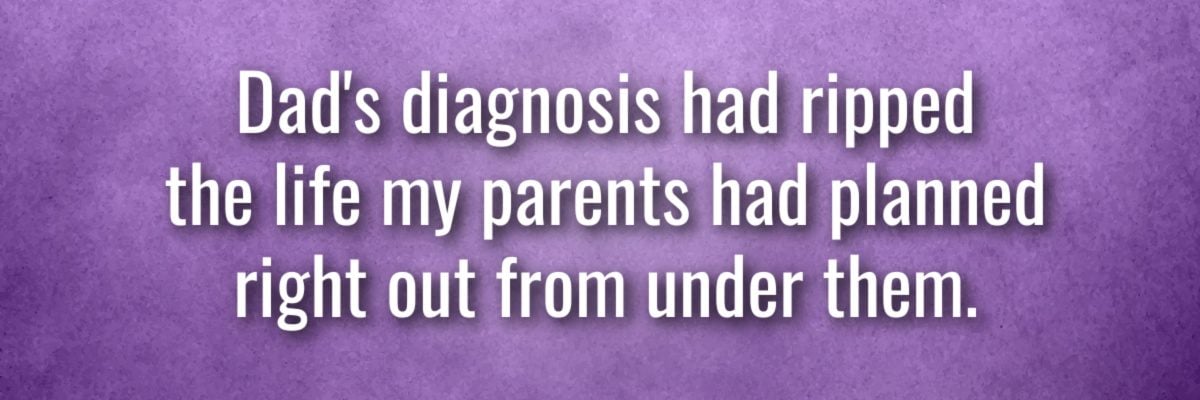
There is caregiving crisis in North America, and around the world. Compounded by a demographic shift with aging boomers, the problem will only grow. It is estimated that 46 per cent of people over 15 years of age have provided care at some point.
I’ll never forget the day of Mom’s big confession. It was about seven years after Dad’s diagnosis, around the time she retired to take care of him full-time. “What you kids and everybody else see on the outside is not what I really feel,” she told me. “Inside I’m a seething b***h.” I was shocked that she said it with such conviction. I didn’t have a clue how to respond.
My mother could be quite funny, or at least she used to be. She was smart, compassionate and to me, the consummate caregiver. Always sharp-witted and honest, she told me that she couldn’t fully embrace the b***h thing or she might be gone forever.
I knew what she meant. Dad’s diagnosis had ripped the life my parents had planned right out from under them. How could she not feel anger and resentment? And yet she believed that if she let that bitterness take over, she wouldn’t be able to go on and live the life they had now—the new normal.
My parents still found joy in some of the old habits, like watching their favourite TV shows together and eating meals they loved. Many people take comfort in the familiar. Indeed, that’s a big part of learning how to cope: understanding that, while so many things have changed, not everything has. This is as true for relationships as it is for routines.
Dad was never demanding. Thankfully, he never became nasty or difficult, or had personality changes, traits that sometimes affect people with MS. For that, I often said a prayer of thanks.
My father loved and appreciated everything Mom ever did for him, no matter how big or small. And she was never angry at Dad, just at the tragic, horrid circumstances caused by a chronic, life-limiting illness. Mom was mad as hell that her handsome, strong, capable husband got one of the worst, most debilitating and often family-destroying diseases of the 20th century. There was no cure, and for Dad, there was little treatment.
It was unbelievable to us kids that our family future was no longer what we’d had in mind. Dad’s life was taken from him and Mom’s from her. Dad comes from a family of long-lived people, and MS doesn’t kill you in and of itself (the patient usually dies of some other cause or complication, rather than the disease). So Mom knew she was in for a life sentence.
Caregiving exacts a toll. Mom was pissed off at the world, but there was a lot of love sprinkled in. Through the 21 years of caregiving for Dad, there was laughter, as well as weddings and babies. There were wonderful outside caregivers, and there were those who didn’t seem to care much at all. There were system obstacles—lots of them—to overcome. Without love, I’m not sure what would have happened to us. We were in it for the long haul. There was no escape.
The flip side of all the sadness, burden and frustration is that most caregivers, like my mom, wouldn’t give up their role for any reason. Citing love and a compulsion to care for their loved one, they say “If not me, then who?” Caregivers want to give, to help, to be there. Good thing too, because the role is all-consuming—physically, spiritually and emotionally. It is unreal. It is real. It is pain and suffering, love and courage. It is also life in its every breath.
If I had to sum up what I observed about my mother’s caregiving, I would call it “resilience in action.” Her behaviours were part of what makes a caregiver resilient—knowing and setting her own boundaries, being aware of her sense of self, not being a martyr. Mom would remind Dad that she was up with him at night, for example. Or tell him when he was fine to wait for her for a time, that everything wasn’t always such an emergency that she had to stop what she was doing and run to him.
A non-resilient caregiver might not view things the same way. They might jump to conclusions, such as telling themselves they are a failure, that they should do more, that they need to sleep in the same room as the person they care for, even if it means doing so in a chair.
Mom told Dad that she had things she needed to do for herself: time in the morning to shower, have a coffee, read the paper or run errands. She was action-oriented and recognized that in order to get everything done, she had to get up at 6 a.m. She needed some time for herself—and for her, it was those few moments of quiet in the morning before tackling the day.
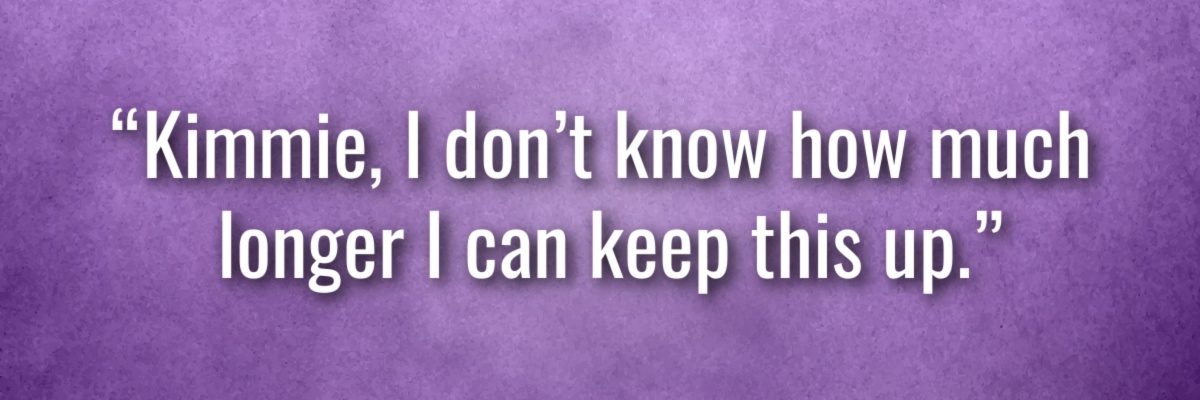
Our family meals went from lots of conversation and laughing to no laughing—only because Dad would laugh and start choking on his food or his saliva, so we had to be mindful. In the later years, taking two hours to feed Dad his supper was the norm.
Over time, Mom accepted some outside help. It wasn’t a lot of time—two hours each morning—but it got Dad ready for the day. Ultimately he even required feeding, which the paid caregivers began to do.
Gradually, Mom had to take over the feeding because they could no longer feed him without causing him to choke. Most of them either couldn’t or didn’t give Dad the time to eat that he needed. Dad was worsening, and eventually it became near impossible for Mom to get much food into him.
“Kimmie, I don’t know how much longer I can keep this up,” she told me one day. “He takes so long to chew that he’s falling asleep with food in his mouth. He chokes and chokes. I don’t know what I should do. If I don’t feed him, he’ll die, but I can’t just sit by and watch that.”
I asked, “Did you talk to him about it?”
“No. What’s the point? The next thing is a feeding tube, and I don’t think he’d want that.”
Not many people in Dad’s condition would have been fed so well. In fact, our family doctor often said, “Myrna, the only reason Donnie is still alive is because of love and the good nutrition you give him.”
Now I knew that she couldn’t go on as they were any more, and neither could Dad. I approached the side of Dad’s bed and asked, “Dad, you hear what Mom and I are talking about in the kitchen, right?”
He nodded as best he could, looking straight at me. He could no longer speak but he certainly understood us, so we always included him in our conversations.
“We just need to know what you want Mom to do,” I said. “We know it’s hard on you, choking on every meal. We need to know what you want. We can place a feeding tube in your stomach.”
He mouthed a definite “No,” then shook his head.
I nodded and replied, “Okay, then. That’s what Mom and I thought you would say.”
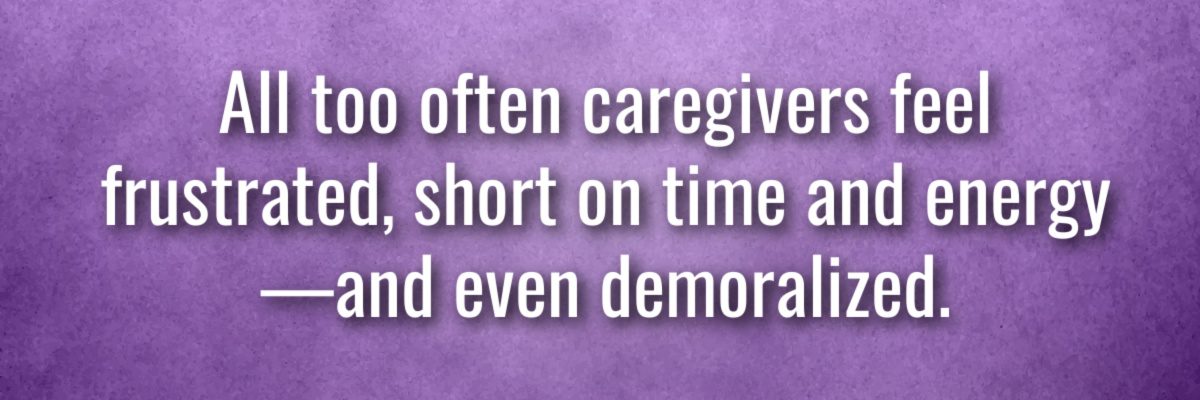
It wasn’t too long after this conversation that Dad died. He got progressively worse, dependent on Mom for everything. She never received more than two hours of help per day, but during the last few weeks the nurse case manager checked in with Mom more often. Our plan was that Dad would die at home.
One day Mom called to say that Dad was failing and it wouldn’t be long. I booked the earliest flight I could for myself, my husband and our one-year-old. That night, as I was packing and making arrangements, Mom held the phone to Dad’s ear so I could say goodbye. I was crying and told him that if he couldn’t wait for me, it was okay. My sister who lived in the United States was also flying in, but my sister and brother who lived near my parents were with them. A few close friends and other family, including our grandmother—Dad’s mother—visited throughout that day and evening.
Dad died at home at 9:30 in the morning on May 16, 2001, about the time our plane was landing. He had most of his family around him and was as comfortable as possible. He was 64.
Through the years of looking after Dad, there were few, if any, signposts. Getting help at decision points was challenging, and finding our way was often a matter of trial and error. Knowing what choices were available in certain situations would have been helpful, as well as understanding how various options might impact the trajectory of Dad’s life, or affect Mom as his caregiver.
Having someone, like a caregiver coach or navigator, would have helped. Mom was left to her own devices when it came to finding the necessary equipment and supplies. Every time Dad deteriorated or faced a new phase with his MS, we would be confronted with new decisions to make.
Unfortunately, all too often caregivers feel frustrated, short on time and energy and even demoralized. They learn that putting one foot in front of the other is the only way to progress.
No one could have done more for my father during his years of illness than my mother. What I witnessed informed my world view of family caregivers. They do whatever it takes for their loved ones—no matter what, regardless of the circumstances or difficulty. They put the care and the caregiving for the other above their own needs—usually because no one else will; perhaps no one else can. And it’s why I know that caregivers deserve help, support, respite and attention.
I hope I can measure up when it’s my turn to care. Because one thing I know for sure is that we—myself, my siblings, my friends—will all be called to care.
Kimberly Fraser, Ph.D., is a retired nurse and former professor of nursing at the University of Alberta. She ran a home health-care business in Edmonton and was the past president of the non-profit Caregivers Alberta.
Excerpted from The Accidental Caregiver, by Dr. Kimberly Fraser. Copyright © 2022, Dr. Kimberly Fraser. Published by Sutherland House Books. Reproduced by arrangement with the publisher. All rights reserved.
Next, check out Kimberly’s self-care tips for caregivers.
The glove compartment is basically the pantry of your car. It’s a convenient—albeit, sometimes messy—place to store all of your driving essentials: insurance information, the vehicle’s owner’s manual, snacks, napkins, hand sanitizer, the list goes on. But that list should never include your cell phone.
Admittedly, there are a number of valid reasons to stash your phone in the glove compartment while you drive. For one, it won’t slide all over the seat or bang around in your cupholder. More importantly, with your phone out of sight, you may be less tempted to check it on the road and avoid a potential accident. A few years back, Ford U.K. and the road-safety organization Brake launched a campaign to start calling glove compartments “phone boxes” for this very reason. Other organizations, like the “Glove It” movement, have also advocated for this habit. (Here are more tips on how to stop texting and driving once and for all.)
The problem is, leaving your phone in your glove compartment can cause serious damage to the device. You’re more likely to forget to take your phone with you when you get out of the car if it’s stored in a place you can’t see it, leaving it vulnerable to extreme temperatures. Exposing your phone to excess heat (around 35˚C or higher) can lead to data loss, corruption, and even permanent battery damage, TIME reports, and a parked car left in 35˚C heat can warm up to 46˚C in just an hour. That means even if your car is left in hot temperatures that don’t reach 35˚C, the interior of your car could still reach that harmful threshold. Storing your phone in the glove compartment doesn’t save it from that heat. In fact, that could make it worse.
Extremely cold temperatures can be just as harmful. According to TIME, phones exposed to cold weather (around -18˚C or below) can experience a shorter battery life, have display problems, or shut off unexpectedly. It could even cause the glass to shatter. (Discover more habits that are shortening the life of your phone.)
Safe driving solutions
So how can you drive around with your phone and keep yourself and your device safe at the same time? If you have an iPhone, use the “Do Not Disturb While Driving” feature, which prevents notifications from popping up while you drive and can send an automatic response to texts explaining that you’re driving. (One study found that this feature is actually effective for drivers.) Apps like LifeSaver can also block texts and calls and even reward you for driving safely. The simplest option is to turn it off altogether.
However, apps don’t solve the problem of where to store your device while you drive. That’s where smartphone car mounts come in. Mounts are both a secure place to store your phone while your text-blocking apps are turned on and a safe way to use your phone as a GPS when necessary. Wirecutter ranked the iOttie Easy One Touch 4 the best smartphone mount for most drivers. It can hold any size phone, and you can choose from a dash/windshield mount, a CD-slot mount, and an air-vent mount.
With these tips, you can not only avoid damage for your phone, but you’ll keep yourself and other drivers safe every time you get behind the wheel.
Find out 10 more things you should never keep in your glove compartment.
Have you ever gotten to the end of the laundry detergent bottle and felt like there was liquid in there, but couldn’t pour it out? TikTok user @chixy38 was tired of tossing perfectly good detergent because it was stuck at the bottom of the bottle, so she shared an amazing hack to help us get every last drop of detergent—and save us so much money.
Open Your Laundry Detergent!
Seriously, you’re going to wonder why you never thought of this before. If your detergent bottle has a plastic pour spout on the top, grab an adjustable wrench or pliers. Use that tool to pop the pour spout off the top. You’ll have instant access to the detergent at the bottom of the bottle.
In this TikTok video, she was able to save enough detergent for seven more loads of laundry! Whoa.
@chixy38Do NOT throw your bottles away before you do this!!! #momlife #laundrytok #laundryhacks #moneysavinghacks♬ original sound – Chixy38
Got a Bottle With a Different Spout?
If your detergent bottle doesn’t have that kind of spout, @chixy38 showed another way to get the spout off. This time, all you need is a shoelace. She wraps it around the lip of the bottle top like a tourniquet, gives a tug and the top pops right off!
Here’s a look:
@chixy38Reply to @alyssapritchett03 #laundryhacks #laundrytok #momlife #moneysavingtips
♬ original sound – Chixy38
Editor’s Note: We tested the shoelace trick to remove the top of a Tide bottle, but weren’t able to make it work. If you find yourself in a similar situation, put the cap on and let the bottle sit overnight. Most of the remaining detergent will drain into the cap.
To get her money’s worth and every last drop of laundry soap out, @chixy38 also recommends flipping the topless bottles over into a cup and letting them sit overnight. This gives them enough time for the detergent to slowly drain from the bottom of the bottle.
@chixy38Reply to @chixy38 #momlife #laundrytok #laundryhacks #moneysavinghacks @vaneamaro91 I feel like you would want to know this 😅♬ original sound – Chixy38
Check out more brilliant laundry hacks that’ll save you time, money and effort!
For something that does so much cleaning—washing is actually in the name—your washing machine isn’t very clean itself, says Jennifer Ahoni, principal scientist for Tide and senior scientific communications manager at P&G Home Care. The damp, dark environment and constant stream of contaminants brought in from your dirty clothes combine to make the perfect environment for growing mould, fungi, and even bacteria.
Why you should clean your washing machine
There are three main benefits to regularly deep cleaning the machine responsible for cleaning your clothes, says Ahoni.
Kill dangerous germs
Your washing machine cleans clothes, but it doesn’t sanitize them, so any germs that come into the washer can spread to other clothes and the machine itself. The consequences of this range from rashes, allergies, and irritation all the way to life-threatening infections.
One 2019 study published in Applied and Environmental Microbiology identified a washing machine as a reservoir of multidrug-resistant pathogens after it infected newborns in a hospital neonatal intensive care unit with bacteria.
A 2015 study published in Frontiers in Microbiology reported that bacteria found in fecal matter from underwear wasn’t killed by the washing machine. What’s more, the washing process spread the germs around to other clothing. (Here’s the only way you should be cleaning your underwear.)
Cleaning and sanitizing your washing machine is how you can both remove and kill these illness-causing bugs.
Remove residue and odours
There’s nothing more frustrating than tossing in a load of dirty clothes only to have them emerge smelling even worse. Mould and fungi thrive in warm, dark, moist environments, making your washing machine their dream house. These can cause health problems, particularly in people who are allergic. But the more common issue is that they can make your clothes smell terrible.
Cleaning your washing machine regularly prevents these toxins from building up and making your laundry reek. “Clean clothes require a clean machine,” Ahoni says.
Keep your expensive machine in top condition
Washing machines are not cheap, and you want yours to last for years. One way to increase the longevity of your machine is to clean it regularly, says Natalie Barrett, cleaning expert and quality supervisor for Nifty Cleaning Services. This keeps the machine’s parts in working order and prevents the buildup of soap, dirt, or clothing fibres from gumming it up.
What to know before you clean your washer
Before starting, it’s important to check the manufacturer’s instructions for cleaning your machine, Ahoni says. Check the user manual or look it up online. Some machines have built-in cleaning cycles, while others require special cleaning solutions.
Cleaning may also depend on the model. For instance, top-loading washers use a different process than front-loading washers. Not following the cleaning instructions can lead to very expensive repairs down the road. (Here are the washer/dryer problems you’ll regret ignoring.)
Once you’ve read up on your specific washer, follow the tips from our experts to make sure you’re getting it as clean as possible.
Daily cleaning tips for your washing machine
What you do daily can make a big difference in how much you need to deep-clean your washer, Ahoni says. The practices below are a good place to start.
- Leave the washer door or lid and the dispenser drawer slightly open when not in use. This allows the interior of your machine to dry out and prevents water from building up inside the drum.
- Remove your clothes as soon as the cycle has finished. Don’t let them sit in the drum any longer than necessary.
- If you have a high-efficiency machine, make sure to use a high-efficiency or “HE” detergent. High-efficiency laundry detergents are specially formulated to prevent excess suds and residue buildup. (Here’s how to tell if you’re using too much laundry detergent.)
- Choose the right cycle for your load, as recommended by the machine manufacturer. The amount of water, the temperature of the water, and the length of time needed to cycle can all make a big difference in how clean your clothes get and how clean the washer stays.
Monthly cleaning and disinfecting
Over time, washing machines build up grime and residue from the detergents used. Dirt and germs can also get trapped inside. This makes your washer less efficient at cleaning your clothes and can lead to more cross-contamination, says Diana Rodriguez-Zaba, cleaning specialist certified by the Institute of Inspection, Cleaning, and Restoration and president of ServiceMaster Restoration by Zaba.
This is why it’s so important to both clean (remove germs, dirt, and debris) and sanitize (kill germs) your washing machine. You should be doing this at least once a month, she says. (Learn where the washing machine filter is and how to clean it.)
Step 1: Empty the washer
Start by emptying the washer of any clothing, detergent, or other items. (Make sure you pick any pocket change gone rogue out of the barrel.)
Step 2: Wipe inside and outside
Use a clean, damp cloth to wipe away any obvious dirt, debris, and especially buildup from detergent or fabric softeners. Yes, this includes the chapstick or gum that accidentally went through the wash and melted to the drum. (Hey, it happens to the best of us!)
Barrett suggests adding a cup or two of baking soda—which just happens to be among the best washing machine cleaners. It will work as an abrasive for a more thorough interior scrubbing. (Be careful with this if your machine has a special interior finish.) You can also use glass cleaner on the window of a front-loading machine and a mild cleaning spray on the rest of it, if you like.
Step 3: Clean the rubber gasket
In front-loading machines, the rubber gasket seals around the door to prevent water from coming out. In top-loading machines, you may see a rubber gasket around the top of the drum or the lid. Use a folded paper towel or toothbrush to clean out any gunk that may have gotten in the cracks and folds. This is a place that stinky mould loves to hide, so be thorough, says Barrett.
Step 4: Run a sterilizing cycle
Depending on the make and model of your washing machine, a sterilizing cycle may be a preprogrammed option (in which case, follow the directions) or you may need to do it yourself. Here’s a natural method for a DIY sanitizing cycle:
- Set the washing machine to the longest and hottest water cycle. Put two cups of baking soda in the drum and turn it on.
- Set the machine for a second long, hot cycle. Add two to four cups of white vinegar—another on the list of best washing machine cleaners—to the drum and turn it on. Note: If you have stubborn smells, it may help to stop the cycle midway through and allow the vinegar-and-water mixture to sit for a couple of hours before finishing the rinse, Rodriguez-Zaba says.
- After both cycles have finished, wipe the drum with a clean cloth dipped in vinegar.
A second method for sanitizing your machine is to use a washing machine cleaner. These products, including cleaning tablets, pouches, and powders, are designed specifically for this purpose. They contain antimicrobial chemicals that kill most kinds of viruses and bacteria, Ahoni says.
Follow the directions on the package. For top-loading machines, put the product directly into the drum. For front-loading machines, put the product in the detergent drawer.
Make cleaning your washing machine a habit
The secret to having fresh, clean laundry is to have a fresh, clean washing machine. Staying on top of routine cleaning will make this so much easier, as it prevents sticky buildup and stains, says Barrett. Make it a part of your laundry routine and you’ll never again wonder why your freshly laundered sheets smell like sweaty socks.
Now that you know how to clean your washing machine, check out 13 cleaning hacks that take the hassle out of housekeeping.
- Go for a walk, do yoga, tai chi or any pleasurable movement activity.
- Get outdoors every day, whether that means walking in nature, exercising your dog or gardening.
- Practise saying no without the need to justify. If you feel you need to add words, then “No, thank you” or “No, that won’t work for me today” are both fine things to say.
- Practise deeper breathing. Deep breathing to a slow count activates our parasympathetic nervous system and calms the body:
Inhale at a slow and steady pace for a count of four and exhale slow and steady for a count of four or five. As you practise, increase to a count of six or eight.
You can add a slight pause at the top of the inhale before exhaling with control for your count.
Hold a brief pause at the end of your exhale as you develop better breath control.
Do this a few times a day or as often as you like for up to 20 minutes. - Spend time with people who make you happy, or take time to call a friend.
- Laugh at least once a day. If you can’t find anything to chuckle at, keep a book of jokes or humour to read from each day.
- Pray, meditate or reflect on something you are grateful for daily. We can all think about and be grateful for many of the things we have in our life, and many of the things we don’t.
- Nurture your hobby of choice. If you have more than one, choose at least one to maintain. Pick one thing you love to do and refuse to let it go—even if you do it for only five minutes.
- Eat healthy foods. Avoid emotional eating. Replace that with some deep breathing or something you can do with your hands.
- Eat one piece of fruit you like each day. It is nourishing for your body, and a sweet snack. (Here are the healthiest fruits you can buy.)
- Take care of your health and make sure you maintain your own regular and necessary health-care appointments: medical, dental, massage therapy and so on.
- Tell yourself three times, at least once a day or as often as you need to, “It is okay to take time for me.” Or replace this with another permission-granting mantra of your choice.
- Be sure to do something that brings you pleasure each day.
- Start a journal: for gratitude, for simple thoughts or just to note what is happening each day. Getting our thoughts down can be therapeutic, but the very act of holding a pen or pencil can also be soothing.
- Get adequate rest and sleep. If you need to access help, then do so. It is hard to function, let alone cope, without feeling sufficiently rested. (Here’s expert advice on how to get a good night’s sleep.)
Kimberly Fraser, Ph.D., is a retired nurse and former professor of nursing at the University of Alberta. She ran a home health-care business in Edmonton and was the past president of the non-profit Caregivers Alberta.
Excerpted from The Accidental Caregiver, by Dr. Kimberly Fraser. Copyright © 2022, Dr. Kimberly Fraser. Published by Sutherland House Books. Reproduced by arrangement with the publisher. All rights reserved.
Now that you’ve got these self-care tips for caregivers in your toolkit, check out 10 mental health podcasts worth adding to your playlist.
